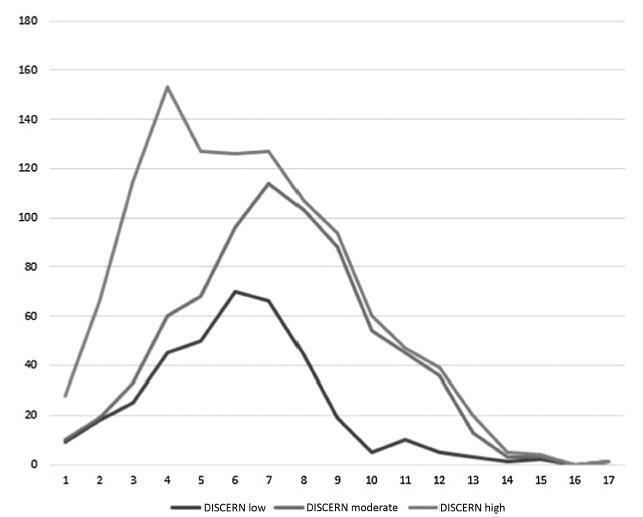-
Original Article06-27-2022
Patient Acceptance of Telemedicine in Urogynecology Consultations – A Cross-Sectional Study Performed at a Brazilian Public Institution
Revista Brasileira de Ginecologia e Obstetrícia. 2022;44(8):755-760
Abstract
Original ArticlePatient Acceptance of Telemedicine in Urogynecology Consultations – A Cross-Sectional Study Performed at a Brazilian Public Institution
Revista Brasileira de Ginecologia e Obstetrícia. 2022;44(8):755-760
Views210See moreAbstract
Objective
To evaluate the acceptance of telemedicine and determine its associated factors in an urogynecology outpatient clinic of a public hospital in Brazil.
Methods
The present was a cross-sectional study performed between June and November 2020. The included patients had their elective appointments postponed due to the coronavirus disease 2019 (COVID-19) pandemic. The variables considered regarding the acceptance of telemedicine were: urogynecologic diagnosis, age, level of schooling, place of residence, access to the internet, type of device used, frequency of internet use, and use of social media platforms. The categorical variables were described by their absolute and relative frequencies. The association among variables was evaluated through the Fisher exact test, and univariate and multivariate analyses, considering the acceptance of telemedicine as the dependent variable.
Results
A total of 225 patients were listed, and 182 agreed to participate. The mean age was 59 years old, 81.3% of the patients had access to the internet, and 87.3% of them accepted telemedicine. There were statistically significant associations regarding the acceptance of telemedicine and high levels of schooling (p< 0.01), internet access (p< 0.01), daily use of the internet (p< 0.01), access through personal mobile phone (p< 0.01), and access through the participant's own residence (p< 0.01). In the univariate and multivariate analyses, only high levels of schooling were associated with the acceptance of telemedicine (Adjusted odds ratio: 4.82; 95% confidence interval = 1.59–14.65).
Conclusion
Most of the urogynecology patients of a public hospital in a developing country accepted telemedicine. Internet access and level of schooling were the factors associated with the acceptance of telemedicine in urogynecology.
-
Original Article09-01-2018
Quality Information about Uterine Fibroids on the Internet
Revista Brasileira de Ginecologia e Obstetrícia. 2018;40(9):547-553
Abstract
Original ArticleQuality Information about Uterine Fibroids on the Internet
Revista Brasileira de Ginecologia e Obstetrícia. 2018;40(9):547-553
Views132See moreAbstract
Objective
There are no published studies analyzing the quality of the information for lay women on the Internet regarding uterine fibroids. The accuracy of the provided material is also unknown. Thus, we have performed a cross-sectional study with 381 websites in the English and Brazilian Portuguese languages between May and December 2017.
Methods
Two investigators performed the analysis, and the Cohen kappa coefficient was calculated to analyze the agreement between them. Search terms (uterine fibroids and derivatives) in the English and Brazilian Portuguese languages were used. The accuracywas analyzed by a 10-itemchecklist created based on the American Society for Reproductive Medicine (ASRM), National Institutes of Health (NIH) and European Menopause and Andropause Society (EMAS) consensuses about uterine fibroids. The item-test correlation and the intraclass coefficient were performed in the 16 questions from the DISCERN instrument, which was designed to measure the quality of health information on the Internet. Analysis of variance (ANOVA) measurements were performed for the independent variables and the DISCERN/accuracy scores.
Results
Google was the most used search engine, and uterine fibroid was the search term that generatedmost of the analyzed material. The median score for accuracy in all websites was 5 out of 10, and the median score of the DISCERN instrument was 38 out of 80. The top-scoring sites in the English language were derived from scientific organizations and federal governments, and they regarded the DISCERN score (The American College of Obstetricians and Gynecologists [ACOG], the Food and Drug Administration [FDA]) and the accuracy criteria (NIH, and FDA). On the other hand, in the Brazilian Portuguese language, the highest scores in both instruments were from magazines or physician’s blogs. The Cronbach α test showed a higher correlation (0.77-0.79) between the sites and DISCERN; however, the item-test correlation varied from 0.39 to 0.56.
Conclusion
There is a need to improve the quality of the information regarding uterine fibroids for lay women.

-
Original Article09-01-2017
The Preference of Women and Men Regarding Female Genital Depilation
Revista Brasileira de Ginecologia e Obstetrícia. 2017;39(9):488-495
Abstract
Original ArticleThe Preference of Women and Men Regarding Female Genital Depilation
Revista Brasileira de Ginecologia e Obstetrícia. 2017;39(9):488-495
Views230See moreAbstract
Purpose
To evaluate the preferences of women and men regarding female pubic hair depilation and identify possible reasons for these preferences.
Methods
This is a cross-sectional study of men and women over 18 years old who were invited by the official blog of our institution to respond anonymously to an online and self-administered questionnairemade by the researchers. The analyses weremade using the Statistical Analysis System (SAS, SAS Inc., Cary, NC, US) software, version 9.3, and contingency tables were used to verify the distribution of variables. The univariate statistical analysis was performed using the Pearson chi-squared test, and the differences for values of p < 0.05 were considered significant.
Results
We obtained data from 69,920 subjects (52,787 women and 17,133 men). Themean age was 31.9 years formen, and 28.5 years for women. Most women (64.3%) and men (62.2%) preferred complete removal of female pubic hair, and this preference wasmore pronounced in younger women andmen. Most women reported performing depilation at home (55.8%), with 44.4% using hot wax and 40.1% using a razor blade. About half of the women (44.7%) and men (50.1%) reported sexual activity, having intercourse 2 to 3 times per week. The frequency of intercourse and sexual satisfaction in women correlated with total pubic hair removal.
Conclusion
Most Brazilian women and men prefer the complete removal of female pubic hair, especially those who are younger andmore sexually active.Women who are satisfied with the appearance of their own genitalia have a stronger preference for complete removal of pubic hair.


